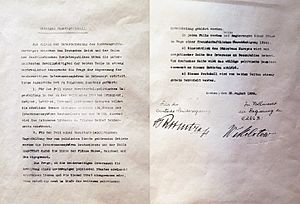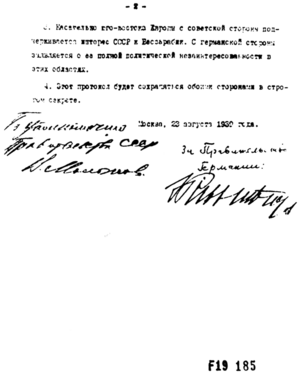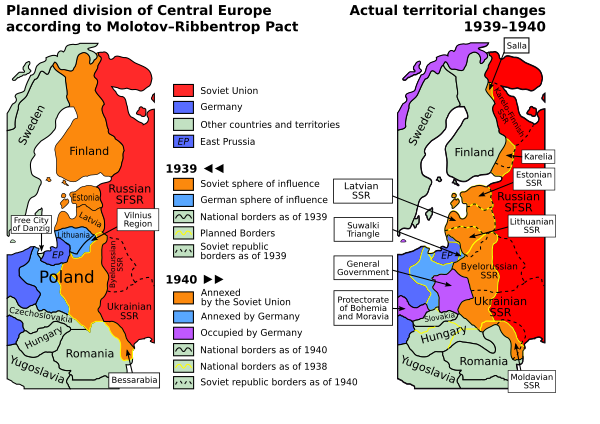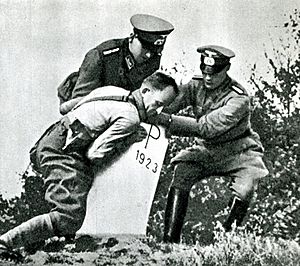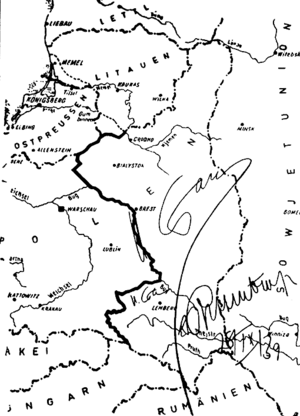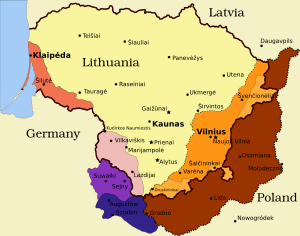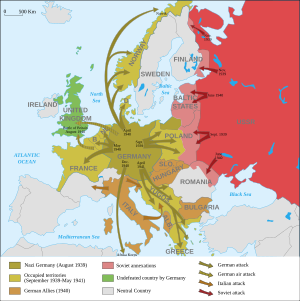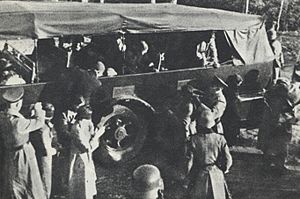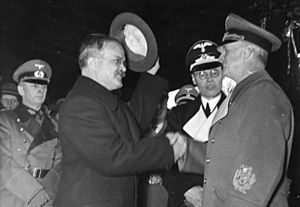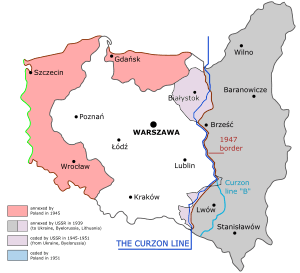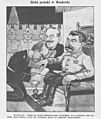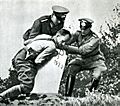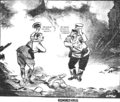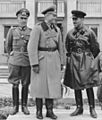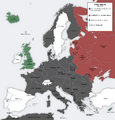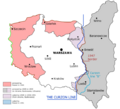Molotov–Ribbentrop Pact facts for kids
| Treaty of Non-Aggression between Germany and the Union of Soviet Socialist Republics | |
|---|---|
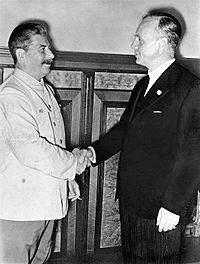
|
|
| Signed | 23 August 1939 |
| Location | Moscow, Soviet Union |
| Expiration | 23 August 1949 (planned) 22 June 1941 (terminated) 30 July 1941 (officially declared null and void) |
| Signatories | |
| Parties | |
| Languages |
|
The Molotov–Ribbentrop Pact was a special agreement between Nazi Germany and the Soviet Union. It was a non-aggression pact, meaning both sides promised not to attack each other. This agreement was signed in Moscow on August 23, 1939.
The pact was signed by German Foreign Minister Joachim von Ribbentrop and Soviet Foreign Minister Vyacheslav Molotov. Its official name was the Treaty of Non-Aggression between Germany and the Union of Soviet Socialist Republics. People also called it the Hitler–Stalin Pact or Nazi–Soviet Pact.
Besides the public agreement, there was a Secret Protocol. This secret part divided parts of Eastern Europe into "spheres of influence" for Germany and the Soviet Union. These areas included parts of Poland, Lithuania, Latvia, Estonia, and Finland. The secret protocol also said Germany wasn't interested in Bessarabia, which was part of Romania. The existence of this secret part was only proven after World War II at the Nuremberg Trials.
Soon after the pact, Germany invaded Poland on September 1, 1939. The Soviet leader Joseph Stalin then ordered the Soviet invasion of Poland on September 17. After these invasions, a new border was set between the two countries. In 1940, the Soviet Union also took parts of Finland, Estonia, Latvia, Lithuania, and parts of Romania.
The pact ended on June 22, 1941, when Germany launched Operation Barbarossa. This was a massive invasion of the Soviet Union. After the war, Ribbentrop was found guilty of war crimes and executed. Molotov died much later in 1986.
Contents
Why Did the Pact Happen?
- Revolutions of 1917–1923
- Aftermath of World War I 1918–1939
- Allied intervention in the Russian Civil War 1918–1925
- Province of the Sudetenland 1918–1920
- 1918–1920 unrest in Split
- Soviet westward offensive of 1918–1919
- Heimosodat 1918–1922
- Austro-Slovene conflict in Carinthia 1918–1919
- Hungarian–Romanian War 1918–1919
- Hungarian–Czechoslovak War 1918–1919
- 1919 Egyptian Revolution
- Christmas Uprising 1919
- Irish War of Independence 1919
- Comintern World Congresses 1919–1935
- Treaty of Versailles 1919
- Shandong Problem 1919–1922
- Polish–Soviet War 1919–1921
- Polish–Czechoslovak War 1919
- Polish–Lithuanian War 1919–1920
- Silesian Uprisings 1919–1921
- Treaty of Saint-Germain-en-Laye 1919
- Turkish War of Independence 1919–1923
- Venizelos–Tittoni agreement 1919
- Italian Regency of Carnaro 1919–1920
- Iraqi Revolt 1920
- Treaty of Trianon 1920
- Treaty of Rapallo 1920
- Little Entente 1920–1938
- Treaty of Tartu (Finland–Russia) 1920–1938
- Mongolian Revolution of 1921
- Soviet intervention in Mongolia 1921–1924
- Franco-Polish alliance 1921–1940
- Polish–Romanian alliance 1921–1939
- Genoa Conference (1922)
- Treaty of Rapallo (1922)
- March on Rome 1922
- Sun–Joffe Manifesto 1923
- Corfu incident 1923
- Occupation of the Ruhr 1923–1925
- Treaty of Lausanne 1923–1924
- Mein Kampf 1925
- Second Italo-Senussi War 1923–1932
- First United Front 1923–1927
- Dawes Plan 1924
- Treaty of Rome (1924)
- Soviet–Japanese Basic Convention 1925
- German–Polish customs war 1925–1934
- Treaty of Nettuno 1925
- Locarno Treaties 1925
- Anti-Fengtian War 1925–1926
- Treaty of Berlin (1926)
- May Coup (Poland) 1926
- Northern Expedition 1926–1928
- Nanking incident of 1927
- Chinese Civil War 1927–1937
- Jinan incident 1928
- Huanggutun incident 1928
- Italo-Ethiopian Treaty of 1928
- Chinese reunification 1928
- Lateran Treaty 1928
- Central Plains War 1929–1930
- Young Plan 1929
- Sino-Soviet conflict (1929)
- Great Depression 1929
- London Naval Treaty 1930
- Kumul Rebellion 1931–1934
- Japanese invasion of Manchuria 1931
- Pacification of Manchukuo 1931–1942
- January 28 incident 1932
- Soviet–Japanese border conflicts 1932–1939
- Geneva Conference 1932–1934
- May 15 incident 1932
- Lausanne Conference of 1932
- Soviet–Polish Non-Aggression Pact 1932
- Soviet–Finnish Non-Aggression Pact 1932
- Proclamation of the Kingdom of Saudi Arabia 1932
- Defense of the Great Wall 1933
- Battle of Rehe 1933
- Nazis' rise to power in Germany 1933
- Reichskonkordat 1933
- Tanggu Truce 1933
- Italo-Soviet Pact 1933
- Inner Mongolian Campaign 1933–1936
- Austrian Civil War 1934
- Balkan Pact 1934–1940
- July Putsch 1934
- German–Polish declaration of non-aggression 1934–1939
- Baltic Entente 1934–1939
- 1934 Montreux Fascist conference
- Stresa Front 1935
- Franco-Soviet Treaty of Mutual Assistance 1935
- Soviet–Czechoslovakia Treaty of Mutual Assistance 1935
- He–Umezu Agreement 1935
- Anglo-German Naval Agreement 1935
- December 9th Movement
- Second Italo-Ethiopian War 1935–1936
- February 26 incident 1936
- Remilitarization of the Rhineland 1936
- Soviet-Mongolian alliance 1936
- Spanish Civil War 1936–1939
- Anglo-Egyptian treaty of 1936
- Italo-German "Axis" protocol 1936
- Anti-Comintern Pact 1936
- Suiyuan campaign 1936
- Xi'an Incident 1936
- Second Sino-Japanese War 1937–1945
- USS Panay incident 1937
- Anschluss Mar. 1938
- 1938 Polish ultimatum to Lithuania Mar. 1938
- Easter Accords April 1938
- May Crisis May 1938
- Battle of Lake Khasan July–Aug. 1938
- Salonika Agreement July 1938
- Bled Agreement Aug. 1938
- Undeclared German–Czechoslovak War Sep. 1938
- Munich Agreement Sep. 1938
- First Vienna Award Nov. 1938
- German occupation of Czechoslovakia Mar. 1939
- Hungarian invasion of Carpatho-Ukraine Mar. 1939
- German ultimatum to Lithuania Mar. 1939
- Slovak–Hungarian War Mar. 1939
- Final offensive of the Spanish Civil War Mar.–Apr. 1939
- Danzig crisis Mar.–Aug. 1939
- British guarantee to Poland Mar. 1939
- Italian invasion of Albania Apr. 1939
- Soviet–British–French Moscow negotiations Apr.–Aug. 1939
- Pact of Steel May 1939
- Battles of Khalkhin Gol May–Sep. 1939
- Molotov–Ribbentrop Pact Aug. 1939
- Invasion of Poland Sep. 1939
Europe After World War I
After World War I, both the German and Russian Empires faced big problems. The Russian Civil War started in Russia. The new Soviet Russia, led by Vladimir Lenin, recognized the independence of Finland, Estonia, Latvia, Lithuania, and Poland. Germany also forced Russia to give up many western territories in the Treaty of Brest-Litovsk.
In 1922, Germany and the Soviet Union signed the Treaty of Rapallo. They agreed not to make claims against each other. They also promised to stay neutral if one was attacked. Trade between them grew in the mid-1920s.
Tensions Rise in the 1930s
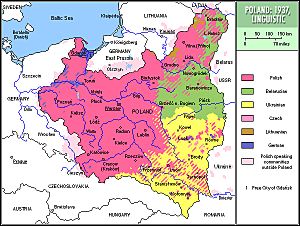
When the Nazi Party and Adolf Hitler came to power in Germany in the 1930s, tensions grew. The Nazis saw Slavic people, like those in the Soviet Union, as "Untermenschen" (subhuman). They also disliked both communism and capitalism. Hitler often spoke of taking land for Germany in the east. This led to a big drop in trade between Germany and the Soviet Union.
In 1936, Germany and Italy supported the Spanish Nationalists in the Spanish Civil War. The Soviets supported the other side, the Spanish Republic. This made the Spanish Civil War a "proxy war" between Germany and the Soviet Union. Germany and Japan also signed the Anti-Comintern Pact in 1936, which Italy joined later. This pact was against communism.
On March 31, 1939, Britain promised to help Poland if its independence was threatened. Hitler was very angry about this. He saw it as Britain trying to stop his plans in Europe. Hitler then started thinking about an alliance with the Soviet Union.
The Munich Agreement and Its Impact
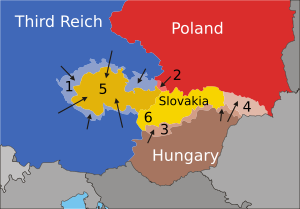
In 1938, Britain and France held the Munich Conference about Czechoslovakia. They decided not to include the Soviet Union. The Munich Agreement allowed Germany to take part of Czechoslovakia. Later, Germany took over all of Czechoslovakia. This policy of "appeasement" made the Soviet Union worry if they would be next. Soviet leaders thought the West wanted Germany to attack the Soviet Union.
Germany also needed raw materials. An alliance with the Soviet Union could help them get these. After the Munich Agreement, Germany needed more military supplies. The Soviet Union also needed new technology and industrial equipment. German war planners knew they would run out of raw materials if they went to war without Soviet supplies.
On March 31, 1939, Britain promised to support Poland, Belgium, Romania, Greece, and Turkey. This was a response to Germany breaking the Munich Agreement. On April 6, Poland and Britain made their promise a military alliance. Hitler then cancelled his non-aggression pact with Poland and a naval agreement with Britain.
In early 1939, the Soviet Union, Britain, and France tried to form a military agreement. Germany secretly hinted to Soviet diplomats that it could offer a better deal. The Soviet Union feared Western powers and wanted a strong military alliance. Britain and France thought war could still be avoided. They also believed the Soviet Union was weak after the Great Purge.
By late May, formal proposals were made. In mid-June, the main talks began. They focused on how to protect Central and Eastern Europe from German aggression. The Soviets wanted to consider a Baltic state turning towards Germany as an "indirect aggression." Britain disagreed, fearing this would let the Soviets interfere in Finland and the Baltic states. This disagreement became a major sticking point. By mid-July, political talks stopped, and military talks began.
The Soviet leaders expected the military talks to fail. They decided to seriously consider German proposals. Military talks started on August 12 in Moscow. The British delegate was not authorized to make strong promises. He was told to prolong talks and avoid saying if Poland would let Soviet troops enter. These talks failed, possibly losing a chance to prevent German aggression.
Negotiations for the Pact

Secret Discussions Begin
From April to July 1939, Soviet and German officials talked about starting political negotiations. No actual talks happened at first. Historian Gerhard L. Weinberg noted that the Soviet Union had wanted good relations with Germany for years.
In May, Stalin replaced his foreign minister, Maxim Litvinov, with Vyacheslav Molotov. Litvinov had favored closer ties with Western countries and was Jewish. Molotov's appointment gave the Soviet Union more freedom in talks with different countries.
On August 23, 1939, German diplomats, led by Ribbentrop, flew to Moscow. A Soviet military band played a German song. The Nazis had planned their arrival carefully. A hammer and sickle symbol was placed next to a swastika flag. Ribbentrop and other German officials were driven to Stalin's office. Stalin and Molotov greeted them, which surprised the Germans. Stalin usually avoided meeting foreign visitors. His presence showed how serious the Soviets were about the talks.
In late July and early August 1939, Soviet and German officials agreed on an economic deal. They then started discussing a political agreement. The Soviets said a political deal could only happen after the economic one.
German pilot Hans Baur, who was there, recalled that Soviet secret police watched their every move. They followed them everywhere. Baur also remembered trying to tip his Russian driver, which made the driver very angry. Taking tips was forbidden and could lead to prison.
August Talks and the Pact Signing
In early August, Germany and the Soviet Union finalized their economic deal. They then began discussing a political alliance. Both sides explained why they had been hostile in the 1930s. They found common ground in their opposition to "capitalist democracies."
At the same time, British, French, and Soviet officials were holding military talks in Moscow. These talks aimed to decide how the three powers would react to a German attack. The main problem was whether Soviet troops could pass through Poland if Germany attacked. Polish officials refused to allow Soviet troops into Poland. They feared the Red Army would never leave.
On August 19, the 1939 German–Soviet Commercial Agreement was signed. On August 21, the Soviets stopped the military talks with Britain and France. That same day, Stalin received promises that Germany would agree to secret protocols. These protocols would place half of Poland, along with Latvia, Estonia, Finland, and Bessarabia, in the Soviet sphere of influence. That night, Stalin agreed to sign the pact and said he would meet Ribbentrop on August 23.
News Spreads

On August 25, 1939, The New York Times reported on the secret Nazi talks. It said the Soviet Union and Germany agreed on Eastern Europe. The next day, the paper reported Japan's anger and French communists' surprise. It also noted Nazi troops moving near Gleiwitz. On August 29, the paper reported that the Soviet parliament had not yet approved the pact. It also mentioned an American professor who believed the pact hid an agreement about "spheres of influence" in Eastern Europe. On August 30, the paper reported a Soviet troop buildup on its western borders.
The Secret Protocol
On August 22, Moscow announced that Ribbentrop would visit Stalin the next day. The Soviets were still talking with British and French missions. But since Western nations would not agree to Soviet demands, Stalin chose a secret German–Soviet pact instead. On August 23, a ten-year non-aggression pact was signed. It included promises of consultation, arbitration if there were disagreements, and neutrality if either side went to war. Neither side would help an enemy of the other.
There was also a secret protocol to the pact. It was only fully revealed after Germany's defeat in 1945. This protocol divided Romania, Poland, Lithuania, Latvia, Estonia, and Finland into German and Soviet "spheres of influence." In the north, Finland, Estonia, and Latvia were given to the Soviet sphere. Poland was to be divided: areas east of the Pisa, Narev, Vistula, and San Rivers would go to the Soviet Union. Germany would take the west.
Lithuania was first assigned to the German sphere. But a second secret protocol in September 1939 moved Lithuania to the Soviet sphere. Lithuania would also get its historic capital, Vilnius, which Poland controlled at the time. Another part of the protocol said Germany would not interfere with Soviet actions toward Bessarabia, then part of Romania. As a result, Bessarabia, Northern Bukovina, and Hertsa regions were taken by the Soviets.
At the signing, Ribbentrop and Stalin had friendly conversations. They toasted each other and talked about their past hostilities. They said Great Britain always tried to disrupt Soviet–German relations. They also claimed the Anti-Comintern Pact was aimed at Western democracies, not the Soviet Union.
What Happened Next?
The agreement shocked the world. Most people knew only about the British–French–Soviet talks. They were surprised by the news of the non-aggression pact. Germany's allies, like Japan, and communist parties worldwide were also surprised.
On August 24, Soviet newspapers published news of the pact's public parts. They showed a famous picture of Molotov signing the treaty with Stalin watching. A German diplomat secretly told Italian and American diplomats about the secret protocol. He mentioned the "spheres of influence" but not the right to annex territories. Time Magazine called the pact the "Communazi Pact."
Soviet propaganda tried to downplay their past opposition to Germany. Molotov even told journalists that "fascism is a matter of taste." Germany also changed its public stance against the Soviet Union. However, Hitler still saw an attack on the Soviet Union as "inevitable."
Concerns about the secret protocol grew. Especially when Soviet negotiators mentioned its contents during talks for military bases in the Baltic states.
The day after the pact was signed, the French-British military delegation asked for an urgent meeting. On August 25, the Soviet negotiator told them that talks were pointless now. That same day, Hitler told the British ambassador that the pact prevented Germany from fighting a two-front war. He said Britain should accept his demands on Poland.
On August 25, Hitler was surprised when Britain and Poland signed a defense pact. Hitler delayed his plans to invade Poland from August 26 to September 1. Because of the defense pact, Britain and France declared war on Germany on September 3.
Impact on Finland, Poland, Baltic States, and Romania
First Invasions and Changes
On September 1, Germany invaded Poland from the west. German forces quickly began killing Polish and Jewish civilians. The German air force also attacked fleeing refugees. The Soviet Union helped German air forces by letting them use signals from a Soviet radio station.
Hitler declared that Poland would never be the same again. He said this was guaranteed by both Germany and Russia.
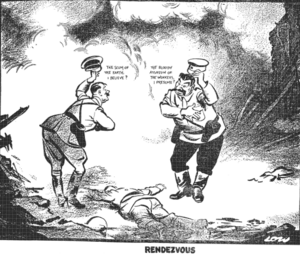
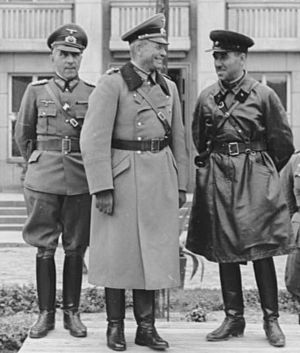
Stalin waited to see if the Germans would stop in their agreed area. He also needed to secure the border after conflicts with Japan. On September 17, the Red Army invaded Poland. This broke the 1932 Soviet–Polish Non-Aggression Pact. They occupied the Polish territory given to them by the Molotov–Ribbentrop Pact. This was followed by coordination with German forces. Polish troops were already fighting stronger German forces in the west. They could not put up much resistance against the Soviets.
On September 18, The New York Times wrote that "Hitlerism is brown communism, Stalinism is red fascism." It said the only real issue was between democracy and despotism.
On September 21, Soviet and German officers signed an agreement in Moscow. It coordinated military movements in Poland. This included "purging" saboteurs and the Red Army helping destroy the "enemy." Joint German–Soviet parades were held in Lvov and Brest-Litovsk. Stalin had decided in August to get rid of the Polish state. Soviet authorities immediately began making the new areas more like the Soviet Union. They held fake elections to make the Soviet takeover of eastern Poland seem legal.
Changes to Secret Protocols
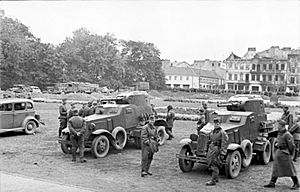
Eleven days after the Soviet invasion of Poland, the secret protocol was changed. This was done by the German–Soviet Treaty of Friendship, Cooperation and Demarcation. Germany got a larger part of Poland. Lithuania was transferred from the German sphere to the Soviet sphere. This happened with the exception of a small area called the "Lithuanian Strip."
On September 28, 1939, the Soviet Union and Germany made a joint statement. They said they had settled problems from the collapse of Poland. They believed it was time to end the war between Germany and England and France. They promised to work together for peace. If their efforts failed, they said England and France would be responsible for the war continuing.
On October 3, the German ambassador in Moscow said the Soviet government would give the city of Vilnius to Lithuania. On October 8, a new Nazi-Soviet agreement was reached. The Baltic states of Estonia, Latvia, and Lithuania were forced to sign a "Pact of Defence and Mutual Assistance." This allowed the Soviet Union to station troops in their countries.
Soviet War with Finland and Other Events
After forcing the Baltic states to sign treaties, Stalin focused on Finland. He thought Finland would give up easily. The Soviets demanded land and a military base near Helsinki, Finland's capital. Finland refused. The Soviets then staged a fake attack on November 26 and used it as an excuse to invade Finland. This started the Winter War on November 30. The Soviets wanted to take over Finland.
Finnish defenses held out for over three months. They caused heavy losses for Soviet forces. The Soviets then agreed to a peace treaty. Finland gave up parts of its territory. About 422,000 Finns lost their homes.
Around this time, Soviet officers also questioned 300,000 Polish prisoners of war. On March 5, 1940, in what became known as the Katyn massacre, 22,000 Polish military members and intellectuals were killed. They were called "nationalists and counterrevolutionaries."
Soviet Occupation of Baltic States and Romania
In mid-June 1940, while the world focused on Germany invading France, Soviet troops raided border posts in Lithuania, Estonia, and Latvia. Their governments were removed and replaced by Soviet officials. These officials deported or killed many people. Elections were held with only pro-Soviet candidates. The new assemblies immediately asked to join the Soviet Union, which was granted. The Soviets took all of Lithuania, even areas meant for Germany.
On June 26, the Soviet Union demanded Bessarabia and Northern Bukovina from Romania. Two days later, Romania agreed. The Soviets occupied these territories. The Hertsa region was also taken by force. Waves of deportations then began in these areas.
Nazi Atrocities Begin
In late October 1939, Germany made disobedience to its occupation a death penalty. Germany began a plan to make occupied territories German. This included kidnapping 50,000–200,000 Polish children to be "Germanized."
The Nazis also planned to kill Polish leaders and educated people. This plan, called Intelligenzaktion, happened soon after the invasion. About 60,000 Polish nobles, teachers, priests, and activists were killed. Later, in May 1940, more than 16,000 educated people were murdered in AB-Aktion.
Germany also planned to take all the land for itself. This led to two million Poles being forced to move. Families had to travel in the harsh winter of 1939–1940. They left behind almost everything. Their property was given to Germans. Germany even planned to move ethnic Poles to Siberia.
Poles and other Slavs were seen as inferior by the Nazis. They were forced to work. Between 1 and 2.5 million Polish citizens were sent to Germany for forced labor. All Polish males had to do forced labor. While Poles faced selective persecution, all ethnic Jews were targeted. In the winter of 1939–40, about 100,000 Jews were sent to Poland. They were put into crowded city ghettos, like the Warsaw Ghetto. Many died there from starvation and disease. Poles and ethnic Jews were imprisoned in many Nazi concentration camps. In Auschwitz, which opened in 1940, 1.1 million people died.
Romania and Soviet Republics
In the summer of 1940, Romania lost more land. This was due to fear of the Soviet Union and German support for its neighbors' demands. The Soviet Union occupied and took Bessarabia, Northern Bukovina, and the Hertsa region from Romania.
On August 30, Germany and Italy gave Northern Transylvania to Hungary. On September 7, Romania gave Southern Dobruja to Bulgaria. After these events, Romania became more like a German-occupied country.
The Soviet-occupied territories became new parts of the Soviet Union. In the two years after the takeover, the Soviets arrested about 100,000 Polish citizens. They deported between 350,000 and 1,500,000 people. Many died, mostly civilians. People were forced to move to gulag labour camps and exile settlements in remote areas of the Soviet Union.
More Secret Protocol Changes
On January 10, 1941, Germany and the Soviet Union signed an agreement. It settled several issues. Secret parts of this new agreement changed the earlier secret protocols. The "Lithuanian Strip" was given to the Soviet Union for $7.5 million. The agreement also officially set the border between Germany and the Soviet Union. It extended trade rules and increased deliveries of goods. It also covered the movement of ethnic Germans to Germany and Baltic and "White Russian" people to the Soviet Union.
German–Soviet Relations

Early Political Issues
Before the Molotov-Ribbentrop pact was announced, Western communists denied it would be signed. They called rumors "Fascist propaganda." However, some people knew that communism and fascism were more alike than commonly thought.
In September 1939, the Comintern (a communist organization) stopped all anti-Nazi propaganda. They said the war in Europe was capitalist countries fighting each other. Western communists then opposed Britain and France for going to war.
When anti-German protests happened in Prague, Czechoslovakia, the Comintern ordered communists there to stop them. Moscow also forced French and British communist parties to oppose the war. French communists, who had first supported the war, were told to condemn it as imperialist. Some communist leaders even left their armies and fled to Russia.
The German Communist Party had similar views. An exiled communist leader said Britain was "the most reactionary force in the world." He argued that Germany wanted friendly relations with the Soviet Union, while England and France wanted war against the Soviet Union.
Despite warnings, German tensions rose when the Soviets said they had to enter Poland to "protect" their people. Molotov later admitted to German officials that this excuse was needed. The Kremlin could not find another reason for the Soviet invasion.
In the early months of the pact, Soviet foreign policy became critical of the Allies and more pro-German. Molotov said Germany had a right to regain its power. He claimed the Allies started an aggressive war to keep the old system.
More Trade and Military Deals
Germany and the Soviet Union signed a large trade agreement on February 11, 1940. It was four times bigger than their 1939 deal. This new pact helped Germany get around a British blockade. In the first year, Germany received huge amounts of cereals, wheat, oil, cotton, and other raw materials. These supplies came through Soviet and occupied Polish territories.
The Soviets were to receive a naval cruiser, plans for the battleship Bismarck, heavy naval guns, and 30 of Germany's newest warplanes. They also got oil and electric equipment, locomotives, turbines, generators, diesel engines, ships, machine tools, and samples of German weapons.
The Soviets also helped Germany avoid British naval blockades. They provided a submarine base near Murmansk. This base allowed German ships to refuel and attack shipping. The Soviets also gave Germany access to the Northern Sea Route for cargo ships and raiders.
Relations Get Worse in Summer
The Soviet invasions of Finland and the Baltic states made relations with Germany worse. Stalin's invasions were not told to the Germans beforehand. This made Germany worry that Stalin was forming an anti-German group. Molotov's reassurances only made the Germans trust them less.
In August 1940, the Soviet Union briefly stopped its deliveries under the trade agreement. This happened after disagreements over Romania and the Winter War. Germany was also falling behind on its deliveries. Stalin worried that Hitler's war with the West might end quickly. This pause caused big resource problems for Germany. By late August, relations improved again. The countries had redrawn borders and settled some claims. Stalin was again convinced Germany would face a long war with Britain.
However, in early September, Germany occupied Romania, targeting its oil fields. This angered the Soviets. They said Germany should have consulted them under the pact.
German–Soviet Axis Talks
In September 1940, Germany joined the Tripartite Pact with Japan and Italy. Ribbentrop invited Molotov to Berlin to discuss forming a "continental bloc." This bloc of Germany, Italy, Japan, and the Soviet Union would oppose Britain and the United States. Stalin sent Molotov to negotiate terms for the Soviet Union to join this group. After talks in November 1940 about where to expand the Soviet sphere of influence, Hitler stopped the discussions. He continued planning to invade the Soviet Union.
Later Relations
To show peaceful intentions toward Germany, the Soviets signed a neutrality pact with Japan on April 13, 1941. Stalin believed this pact was important for its political meaning to Germany. Stalin thought there was a growing disagreement in Germany about whether to start a war with the Soviet Union. He did not know that Hitler had been secretly planning an invasion of the Soviet Union since summer 1940. Hitler had ordered his military to prepare for war in the East, regardless of any talks.
The Pact Ends
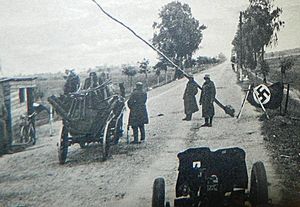
Germany ended the pact on June 22, 1941, at 3:15 AM. They launched a massive attack on the Soviet Union in Operation Barbarossa. Stalin had ignored many warnings that Germany would invade. He did not order a "full-scale" mobilization of forces, though some mobilization was happening. After the invasion, the territories the Soviet Union gained from the pact were lost in weeks. Within six months, the Soviet military had suffered millions of casualties. The export of Soviet raw materials to Germany continued until the invasion. These exports helped Germany maintain its supplies of rubber and grain.
Aftermath of the Pact
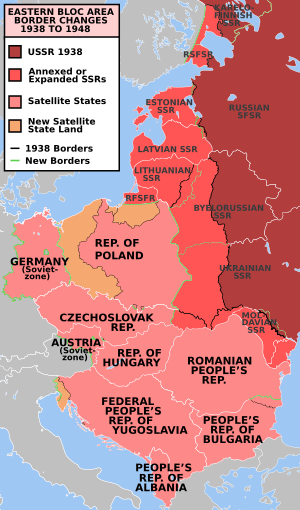
Finding the Secret Protocol
The original German copy of the secret protocols was likely destroyed during bombings. But in late 1943, Ribbentrop had the most secret German Foreign Office records microfilmed. After the war, a civil servant named Karl von Loesch, who had these microfilms, decided to bury them instead of destroying them. He hoped they would help him later.
In May 1945, von Loesch told British Lieutenant Colonel Robert C. Thomson about the microfilms. He wanted special treatment in return. Thomson and an American officer agreed to move von Loesch if he produced the microfilms. The microfilms contained a copy of the Non-Aggression Treaty and the Secret Protocol. An American official found these documents in August 1945.
News of the secret protocols first came out during the Nuremberg trials. Alfred Seidl, a lawyer for one of the defendants, presented a statement describing them. It was written from memory by a Nazi Foreign Office lawyer who was present at the signing. Later, Seidl got the German text of the secret protocols from an unknown Allied source. He tried to use them as evidence. The Allied prosecutors objected, but a witness was allowed to describe them from memory.
Finally, an American prosecutor got a copy of the secret protocols and had them translated. They were first published on May 22, 1946, in a newspaper. Later, they were published in Britain.
The protocols gained more attention when they were included in an official US State Department collection in 1948. This publication made headlines worldwide. US officials saw it as a success in the "propaganda war" against the Soviet Union.
Despite the publication, the Soviet Union officially denied the secret protocol for decades. Vyacheslav Molotov, one of the signers, denied its existence until he died. The French Communist Party did not admit it existed until 1968.
On August 23, 1986, thousands of people protested in many Western cities. These "Black Ribbon Day" rallies aimed to draw attention to the secret protocols.
Soviet Denial and Later Admission
In response to the secret protocols being published, Stalin released a book called Falsifiers of History. It claimed that Stalin rejected Hitler's idea of dividing the world. It did not mention the Soviet offer to join the Axis powers. This version of events was taught in the Soviet Union until it broke apart.
The book also claimed that the Munich agreement was a "secret agreement" between Germany and the West. It said this agreement was meant to push Hitler against the Soviet Union.
For decades, the Soviet Union officially denied the secret protocol. But in 1989, a commission led by Alexander Nikolaevich Yakovlev investigated. They concluded that the protocol had existed. The Soviet parliament then confirmed its existence and condemned it. The Soviet government finally admitted and condemned the Secret Treaty. Mikhail Gorbachev, the last Soviet leader, also condemned the pact.
Vladimir Putin has called the pact "immoral" but also a "necessary evil." In 2019, Putin said the pact was no worse than the 1938 Munich Agreement, which led to the division of Czechoslovakia.
Both Germany and the Soviet Union's successor states have declared the secret protocols invalid. The Federal Republic of Germany did so on September 1, 1989. The Soviet Union did so on December 24, 1989.
The Soviet copy of the original document was made public in 1992. In August 2009, Russian Prime Minister Vladimir Putin again condemned the Molotov–Ribbentrop Pact as "immoral."
Some new Russian historians and revisionists, like Aleksandr Dyukov, say the pact was necessary. They argue it was because Britain and France failed to form an anti-fascist pact.
Images for kids
-
Stalin and Ribbentrop shaking hands after the signing of the pact in the Kremlin
-
Map of the Second Polish Republic, 1937
-
All territories taken from Czechoslovakia by its neighbours in October 1938 (Munich Agreement) and March 1939
-
"The Prussian Tribute in Moscow" in the Polish satirical newspaper Mucha of 8 September 1939
-
The New York Times reported Nazi troop movement on 25 August 1939, soon before the Gleiwitz incident on 31 August 1939, led by Alfred Naujocks (pictured).
-
Cartoon in the Evening Standard depicting Hitler greeting Stalin after the invasion of Poland, with the words: "The scum of the earth, I believe?" To which Stalin replies: "The bloody assassin of the workers, I presume?"; 20 September 1939.
-
Common parade of Wehrmacht and Red Army in Brest at the end of the invasion of Poland. At the centre are Major General Heinz Guderian and Brigadier Semyon Krivoshein.
-
Soviet and German soldiers in Lublin
-
"Second Ribbentrop–Molotov Pact" of 28 September 1939. Map of Poland signed by Stalin and Ribbentrop (focused on the Kresy) adjusting the German-Soviet border in the aftermath of German and Soviet invasion of Poland.
-
German and Soviet soldiers meet in jointly-occupied Brest.
-
The new border between Nazi Germany and Soviet Union from September 1939 to June 1941, somewhere in the occupied territory of Poland
-
Soviet expansion, changes to Central European borders and creation of the Eastern bloc after World War II
See also
 In Spanish: Pacto Ribbentrop-Mólotov para niños
In Spanish: Pacto Ribbentrop-Mólotov para niños
Molotov–Ribbentrop Pact
- Baltic Way, protest marking the 50th anniversary of the Molotov–Ribbentrop Pact
- Gestapo–NKVD conferences
- Molotov–Ribbentrop Pact negotiations
- Timeline of the Molotov–Ribbentrop Pact
- Walter Krivitsky, Soviet defector who revealed plans of the non-aggression pact before World War II
Related
- German-Soviet Axis talks
- German–Soviet Boundary and Friendship Treaty
- German–Soviet military parade in Brest-Litovsk
- Italo-Soviet Pact
- Nazi–Soviet population transfers
- Soviet–Japanese Neutrality Pact
- Stalin's alleged speech of 19 August 1939




